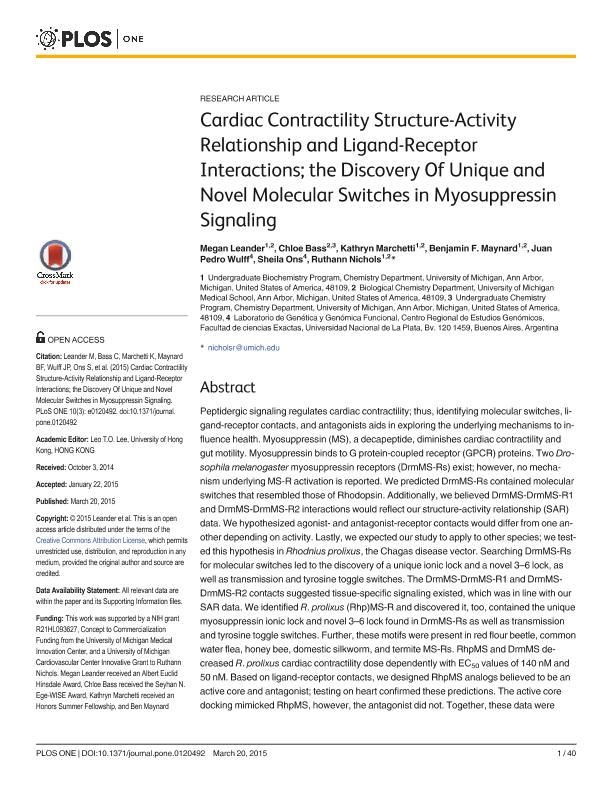Mostrar el registro sencillo del ítem
dc.contributor.author
Leander, Megan
dc.contributor.author
Bass, Chloe
dc.contributor.author
Marchetti, Kathryn
dc.contributor.author
Maynard, Benjamin F.
dc.contributor.author
Wulff, Juan Pedro

dc.contributor.author
Ons, Sheila

dc.contributor.author
Nichols, Ruthann
dc.date.available
2018-07-30T17:21:37Z
dc.date.issued
2015-03
dc.identifier.citation
Leander, Megan; Bass, Chloe; Marchetti, Kathryn; Maynard, Benjamin F.; Wulff, Juan Pedro; et al.; Cardiac contractility structure-activity relationship and ligand-receptor interactions; the discovery of unique and novel molecular switches in myosuppressin signaling; Public Library of Science; Plos One; 10; 3; 3-2015; 1-40; e0120492
dc.identifier.issn
1932-6203
dc.identifier.uri
http://hdl.handle.net/11336/53412
dc.description.abstract
Peptidergic signaling regulates cardiac contractility; thus, identifying molecular switches, ligand-receptor contacts, and antagonists aids in exploring the underlying mechanisms to influence health. Myosuppressin (MS), a decapeptide, diminishes cardiac contractility and gut motility. Myosuppressin binds to G protein-coupled receptor (GPCR) proteins. Two Drosophila melanogaster myosuppressin receptors (DrmMS-Rs) exist; however, no mechanism underlying MS-R activation is reported. We predicted DrmMS-Rs contained molecular switches that resembled those of Rhodopsin. Additionally, we believed DrmMS-DrmMS-R1 and DrmMS-DrmMS-R2 interactions would reflect our structure-activity relationship (SAR) data. We hypothesized agonist- and antagonist-receptor contacts would differ from one another depending on activity. Lastly, we expected our study to apply to other species; we tested this hypothesis in Rhodnius prolixus , the Chagas disease vector. Searching DrmMS-Rs for molecular switches led to the discovery of a unique ionic lock and a novel 3-6 lock, as well as transmission and tyrosine toggle switches. The DrmMS-DrmMS-R1 and DrmMS-DrmMS-R2 contacts suggested tissue-specific signaling existed, which was in line with our SAR data. We identified R. prolixus (Rhp)MS-R and discovered it, too, contained the unique myosuppressin ionic lock and novel 3-6 lock found in DrmMS-Rs as well as transmission and tyrosine toggle switches. Further, these motifs were present in red flour beetle, common water flea, honey bee, domestic silkworm, and termite MS-Rs. RhpMS and DrmMS decreased R. prolixus cardiac contractility dose dependently with EC50 values of 140 nM and 50 nM. Based on ligand-receptor contacts, we designed RhpMS analogs believed to be an active core and antagonist; testing on heart confirmed these predictions. The active core docking mimicked RhpMS, however, the antagonist did not. Together, these data were consistent with the unique ionic lock, novel 3-6 lock, transmission switch, and tyrosine toggle switch being involved in mechanisms underlying TM movement and MS-R activation, and the ability of MS agonists and antagonists to influence physiology.
dc.format
application/pdf
dc.language.iso
eng
dc.publisher
Public Library of Science

dc.rights
info:eu-repo/semantics/openAccess
dc.rights.uri
https://creativecommons.org/licenses/by-nc-sa/2.5/ar/
dc.subject
Myosuppressin
dc.subject
Cardiac Contractily
dc.subject
Agonist
dc.subject
Antagonis
dc.subject.classification
Otras Ciencias Biológicas

dc.subject.classification
Ciencias Biológicas

dc.subject.classification
CIENCIAS NATURALES Y EXACTAS

dc.title
Cardiac contractility structure-activity relationship and ligand-receptor interactions; the discovery of unique and novel molecular switches in myosuppressin signaling
dc.type
info:eu-repo/semantics/article
dc.type
info:ar-repo/semantics/artículo
dc.type
info:eu-repo/semantics/publishedVersion
dc.date.updated
2018-07-30T13:38:10Z
dc.journal.volume
10
dc.journal.number
3
dc.journal.pagination
1-40; e0120492
dc.journal.pais
Estados Unidos

dc.journal.ciudad
San Francisco
dc.description.fil
Fil: Leander, Megan. University of Michigan; Estados Unidos
dc.description.fil
Fil: Bass, Chloe. University of Michigan; Estados Unidos
dc.description.fil
Fil: Marchetti, Kathryn. University of Michigan; Estados Unidos
dc.description.fil
Fil: Maynard, Benjamin F.. Universidad Nacional de La Plata. Centro Regional de Estudios Genómicos; Argentina. Consejo Nacional de Investigaciones Científicas y Técnicas; Argentina
dc.description.fil
Fil: Wulff, Juan Pedro. Universidad Nacional de La Plata. Centro Regional de Estudios Genómicos; Argentina. Consejo Nacional de Investigaciones Científicas y Técnicas; Argentina
dc.description.fil
Fil: Ons, Sheila. Universidad Nacional de La Plata. Centro Regional de Estudios Genómicos; Argentina
dc.description.fil
Fil: Nichols, Ruthann. University of Michigan; Estados Unidos
dc.journal.title
Plos One

dc.relation.alternativeid
info:eu-repo/semantics/altIdentifier/doi/http://dx.doi.org/10.1371/journal.pone.0120492
dc.relation.alternativeid
info:eu-repo/semantics/altIdentifier/url/https://www.ncbi.nlm.nih.gov/pmc/articles/PMC4368603/
dc.relation.alternativeid
info:eu-repo/semantics/altIdentifier/url/http://journals.plos.org/plosone/article?id=10.1371/journal.pone.0120492
Archivos asociados
